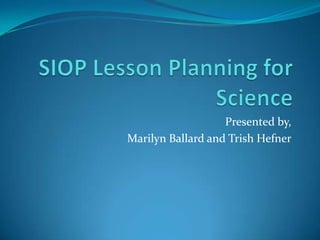
Siop pd bb. ci. s
- 1. Presented by, Marilyn Ballard and Trish Hefner
- 2. Key components of a SIOP lesson plan Today we will focus on: 1. Building Background- Link concepts to past learning, Key Vocabulary 2. Comprehensible Input- Teacher/Instructional Strategies 3. Strategies- Scaffolding, higher order questions, graphic organizers
- 3. Sample SIOP Content and Language Objectives for a Science Lesson CO- Students will observe that light travels in a straight line and is reflected and/or absorbed. LO- We will: Tell predictions of which objects transmit or reflect light to our partner read the procedures for the experiment write and classify our data discuss our conclusions with another partner pair
- 4. Guidelines to ACHIEVE Comprehensible Input TEACHER SPEECH and BEHAVIOR Use expression and body language Speak slowly and clearly Pause more between phrases Use shorter sentences with simpler syntax Stress high frequency vocabulary Repeat and review vocabulary Clarify words throughout the lesson Open discussion to different perspectives on the topic Maintain a warm, supportive, friendly environment!
- 5. Guidelines to ACHIEVE Comprehensible Input Instructional Strategies Use visuals! Use graphic organizers Explain processes and tasks clearly and MODEL Communicate the subject in oral, written, physical and/or pictorial form Provide hands-on opportunities Promote critical thinking Incorporate cooperative learning opportunities Adjust your instruction to meet every child’s needs!
- 6. Focus on Vocabulary! Identifying key vocabulary is vital to helping English learners master both the content and the academic language to demonstrate their knowledge. REMEMBER 3 EASY STEPS: 1. State the word 2. Define the Word 3. Practice and Apply the word Additional examples with oral and written practice will also benefit all learners, especially English Learners, allowing them to internalize the words.
- 7. KEY VOCABULARY includes… Content words- these are the key vocabulary words, terms, and concepts associated with a particular topic being taught in science. Process/function words- these include functional language; language used in the classroom for processes and tasks such as the scientific process words. Structural Words – these are words that enable students to learn new vocabulary, primarily based on English morphology. For example – if a science teacher is teaching photosynthesis, he/she can help students learn the meaning of that word by introducing the root – photo meaning light, then comparing the words photosynthesis, photocopy, photograph to see that these words are related in both spelling and meaning.
- 8. ZIPLINE VOCABULARY REVIEW GAME Use this engaging activity as a quick review of your key vocabulary terms for the lesson Materials needed- large index cards, printed words and printed definitions, start of the line and end of the line statements. 1. Choose your key vocabulary terms and their definitions. 2. The first student will hold the initial card that states “This starts the line.” and the first word. 3. The next student will line up holding the card with the definition of the first word and the next vocabulary word. This process will continue until the last person has the last definition and the statement “This ends the line.” Expectations- Students are to move about the “Zipline” without speaking while matching their vocabulary words and definitions. Students will discuss their accuracy and justify their positions in the “Zipline” What did you notice about each word and it’s definition in the Zipline? How could all students benefit from this review task?
- 9. HELPFUL HINTS for differentiating the ZIPLINE Stickers on the key vocabulary term but not the definition Use the same font for both the word and its definition if necessary for all students to be successful. Provide a 30 second talk time for students to discuss the words on their cards before the silent zipline occurs.
- 10. Scientific Inquiry in SIOP utilizes these strategies… 1. Learner engages in scientifically oriented questions 2. Learner collects and records evidence in responding to questions 3. Learner formulates explanations from evidence 4. Learner connects explanation to scientific knowledge 5. Learner communicates and justifies explanations.
- 11. Bloom’s Taxonomy Higher Order Thinking Skills Level Functions Remember Recognizing, recalling Understand Interpreting, exemplifying, classifying, summarizing, inferring, comparing, explaining Apply Executing, implementing Analyze Differentiating, organizing, attributing Evaluate Checking, critiquing Create Generating, planning, producing
- 12. Examples of higher order questioning: Imagine that you have just finished reading a novel with students, here are sample questions that you could ask on every level of the taxonomy. Remember: What are the six kingdoms of living things? Understand: How are living things classified into kingdoms? Apply: If a new life form were discovered, what process would you use to assign it to a kingdom? Analyze: How are fungi and plants similar to and different from each other? Evaluate: Should the classification of living things be based on their genetic similarities or their morphology/physiology? What are the reasons for your choice? Create: Think about some objects commonly found in your kitchen. How would you set up a classification system for those objects? What would be the rules of your classification system?
- 13. NOW YOU TRY! Use the Verb List for Bloom’s Taxonomy and the chart paper to write 3 higher order questions for your current science unit. Write an analysis, evaluation, and create question please. Display your poster when you are finished and be ready to share.
- 14. Scaffolding in Science Meet the kids where they are and take them to where they need to be…. - Procedural Scaffolding- one on one teaching, coaching, modeling, small group instruction, heterogeneously grouping students - Instructional Scaffolding- graphic organizers as pre-reading or pre-writing tools to support class discussion - Verbal Scaffolding- paraphrasing, using “think alouds”, reinforcing contextual definitions, recast – correcting pronunciation
- 15. Helpful Learning Strategies for Science Lessons: Task-Based Use Background Knowledge Make Inferences Make Predictions Use Images Use your Kinesthetic Sense Find/Apply Patterns Classify/Sequence information Take Notes Summarize Use Selective Attention Cooperate Talk to Yourself – Self-Talk